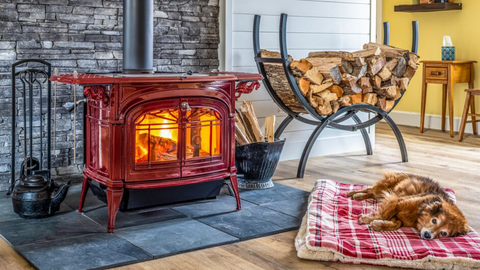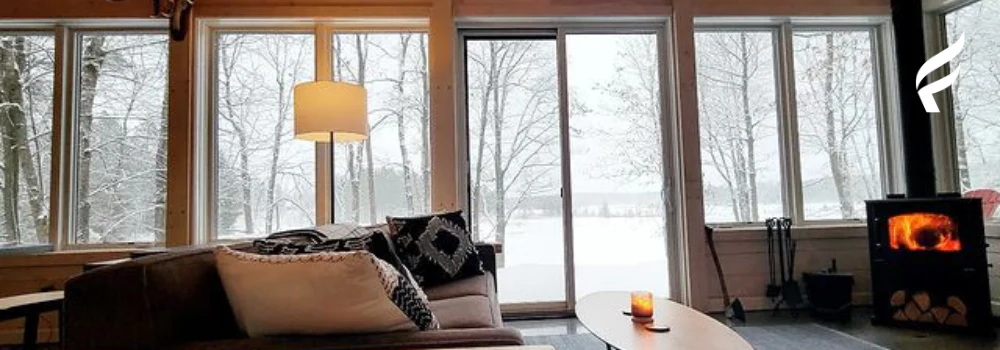Wood-burning stoves are built to be durable, often lasting for decades with the right care. But like any appliance, they eventually reach the point where performance starts to decline and replacement becomes inevitable.
Knowing how long a wood stove lasts (and the signs it’s nearing the end of its life) helps you plan ahead, protect your investment and keep your home safe and warm. In this guide, you’ll learn what affects a stove’s lifespan, how to spot warning signs and what to consider when choosing a replacement.
Explore Forge & Flame Wood Stoves or Find a Dealer Near You
How Long Does a Wood Stove Last?

On average, a wood-burning stove lasts 10 to 20 years. The exact lifespan depends on several factors, but many homeowners also ask how long do wood stoves last when used daily versus occasionally. The answer varies, but proper care can push your stove closer to the 20-year mark.
A common question is how long does a wood burning stove last compared to other heating appliances. The truth is, it depends largely on the materials, frequency of use and upkeep.
-
Materials: Cast iron and steel stoves are known for their longevity, but cast iron requires more upkeep to prevent rust, while steel stoves offer lighter construction with strong durability.
-
Usage: A stove used daily through long winters will wear out faster than one used occasionally for ambiance.
-
Maintenance: Regular cleaning, burning seasoned hardwood and scheduling annual inspections dramatically extend the life of your stove.
High-quality, EPA-certified stoves are designed to outperform older models. While some wood stoves have lasted for decades, most homeowners find that 15 years is a realistic expectation before performance begins to decline.
The Lifespan of a Wood Stove
While some wood stoves have been in use for several decades, it’s best to replace yours a bit sooner. An EPA-certified wood stove that meets modern quality, safety and efficiency standards will typically last ten to twenty years, with proper maintenance and care. To get the most out of your investment, you’ll need to keep a couple of things in mind when searching for your new wood stove.
First, it’s important to invest in a high-quality, efficient wood stove. While there may be more inexpensive options available, the longevity, efficiency and safety of a top-of-the-line Vermont Castings or Quadra-Fire stove are well worth the initial expense. Once you’ve chosen your stove, be sure that it’s installed in accordance with the manufacturer's specifications so that you’re confident that your stove is as safe and efficient as it can be. Regular, thorough maintenance and cleaning will go a long way in prolonging your stove’s effective lifespan.
Signs You Need to Replace Your Wood Stove
No stove lasts forever. The good news is that there are clear signs to help you know when replacement is the safer and smarter choice. If you notice consistent issues, it may be time to move on to a new model that burns more efficiently and safely.
Poor Performance
When your stove takes longer to heat your space, requires far more wood than it used to, or struggles to maintain steady heat, it’s often a sign of worn-out components. An inefficient stove not only wastes fuel but also costs you more in the long run.
Warping or Cracking
Warped steel, cracked cast iron, or visible damage to the stove body means the structure has been compromised. These problems affect both safety and performance. Structural damage usually cannot be repaired and should be treated as a clear replacement signal.
Excessive Smoke
If your wood stove produces too much smoke, inside your home or from the chimney, it could mean the airflow system is damaged, the firebox is deteriorating, or the stove is no longer functioning properly. Excessive smoke reduces efficiency, harms air quality and can increase creosote buildup, raising the risk of chimney fires.
Read more in The Complete Guide to EPA-Certified Stoves.
How to Extend the Life of Your Wood-Burning Stove
Proper care can easily add years to your stove’s lifespan. The basics include:
-
Burn seasoned hardwood only: Dry wood with less than 20% moisture content creates hotter, cleaner fires.
-
Clean regularly: Empty ash pans, brush out soot and keep the glass free of buildup.
-
Schedule annual inspections: A professional can check seals, gaskets and the chimney for damage or excessive creosote.
-
Avoid overfiring: Continuously burning at maximum output can stress metal parts and shorten the stove’s life.
With consistent upkeep, many stoves exceed the 20-year mark while maintaining efficient performance.
Wood Stove Parts that Normally Wear Out
Even if your stove body remains solid, some parts naturally wear down over time. Replacing them promptly helps your stove perform like new:
-
Gaskets: These seals around doors and glass wear out and cause leaks. Replacing them restores efficiency.
-
Baffles: These interior plates direct airflow and help combustion. When they warp or crack, efficiency drops until replaced.
-
Glass panels and handles: Exposure to heat eventually weakens glass and hardware, both of which are easy to swap.
If you notice these parts wearing out more quickly, it’s often a sign that the stove itself may be nearing the end of its overall lifespan.
Learn more in our Wood Stove Maintenance Tips blog.
How to Dispose of Your Old Wood Stove
When it’s time for a new stove, disposal of your old unit should be done responsibly. Many homeowners choose one of these options:
-
Recycling or scrapping: Because stoves are made of steel or cast iron, they can often be recycled at a local facility.
-
Donation: If the stove is still functional but outdated, some organizations may accept it for repurposing.
-
Municipal pickup: Some towns offer large-item pickup or metal scrapping programs for appliances.
Improper disposal can create environmental issues, so always choose eco-friendly options.
State and County Wood Stove Exchange Programs
Another option is participating in a wood stove exchange program. Many states and counties offer rebates or financial incentives for turning in old, non-EPA-certified stoves and replacing them with modern, efficient models. These programs make it easier to upgrade while supporting cleaner air and reduced emissions.
Check your area’s State Rebate & Credits page to see if you qualify for savings.

Contact a Dealer to Get the Best Forge & Flame Wood Stove for Your Home
A wood-burning stove can last for decades, but how long do wood burning stoves last ultimately comes down to quality, upkeep and usage. When efficiency fades or safety becomes a concern, upgrading ensures your home stays warm, efficient and safe.
Forge & Flame wood stoves are crafted with premium materials and engineered for dependable performance. Whether you’re replacing an older model or buying your first, our designs combine durability, efficiency and timeless style. With options to fit every home, you’ll find a stove that delivers lasting comfort year after year.
If you’re ready to make the switch, we’re here to help. Browse Forge & Flame Wood Stoves or Find a Dealer Near You today.


